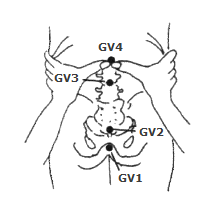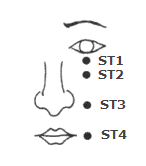- HOME »
- Meridians »
- Governor Vessel Meridian(GV)
Governor Vessel Meridian(GV) 督脈
◐ GV-1 長強 ◐ GV-2 腰兪 ◐ GV-3 腰陽関 ◐ GV-4 命門 ◐ GV-5 懸枢 ◐ GV-6 脊中 ◐ GV-7 中枢 ◐ GV-8 筋縮 ◐ GV-9 至陽 ◐ GV-10 霊台 ◐ GV-11 神道 ◐ GV-12 身柱 ◐ GV-13 陶道 ◐ GV-14 大椎 ◐ GV-15 瘂門 ◐ GV-16 風府 ◐ GV-17 脳戸 ◐ GV-18 強間 ◐ GV-19 後頂 ◐ GV-20 百会 ◐ GV-21 前頂 ◐ GV-22 顖会 ◐ GV-23 上星 ◐ GV-24 神庭 ◐ GV-25 素髎 ◐ GV-26 水溝 ◐ GV-27 兌端 ◐ GV-28 齦交
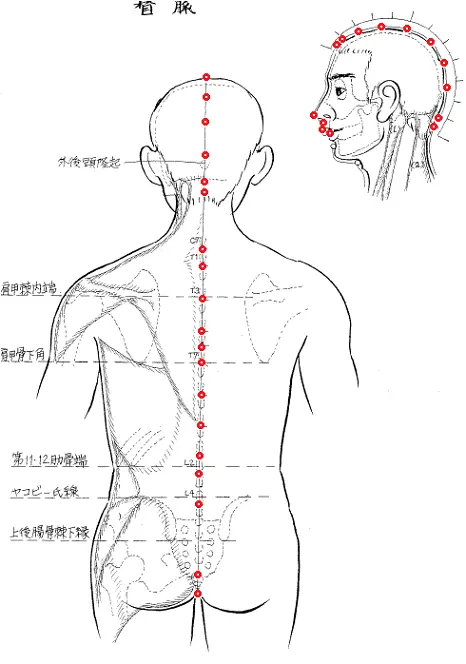
GV-1 長強
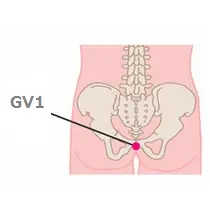
WHO : In the perineal region, inferior to the coccyx,
midway between the tip of the coccyx
and the anus.
Note: The subject may be in prone position
or knee-chest position.
GV-2 腰兪
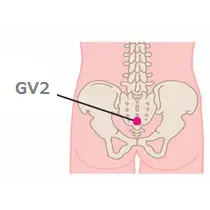
WHO : In the sacral region, at the sacral hiatus, onthe posterior median line.
Note: The sacral hiatus is a small depression immediately above the anal cleft.
GV-3 腰陽関
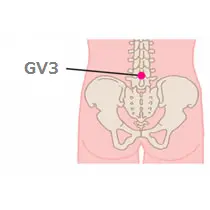
WHO : In the lumbar region, in the depression inferior to the spinous process of the fourth lumbar vertebra (L4), on the posterior median line.
Note: GV3 can be located by first palpating the highest points of the iliac crests and the spinous process of the fourth lumbar vertebra (L4) can then be found at the midpoint of the highest points of both iliac crests.
GV-4 命門
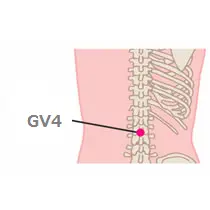
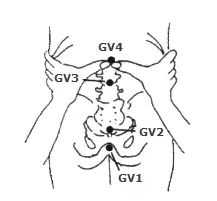
WHO : In the lumbar region, in the depression inferior to the spinous process of the second lumbar vertebra (L2), on the posterior median line.
Practical : GV-4 is the back side of the navel.
GV-5 懸枢
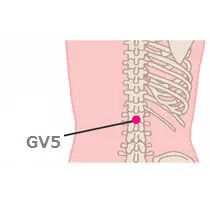
WHO : In the lumbar region, in the depression inferior to the spinous process of the first lumbar vertebra (L1), on the posterior median line.
GV-6 脊中
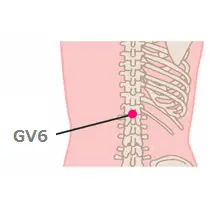
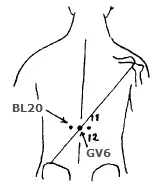
WHO : In the upper back region, in the depression inferior to the spinous process of the 11th thoracic vertebra (T11), on the posterior median line.
GV-7 中枢
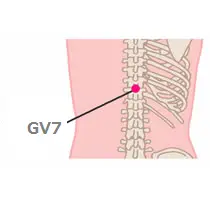
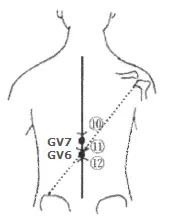
WHO : In the upper back region, in the depression inferior to the spinous process of the 11th thoracic vertebra (T11), on the posterior median line.
GV-8 筋縮
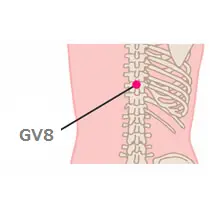
WHO : In the upper back region, in the depression inferior to the spinous process of the ninth thoracic vertebra (T9), on the posterior median line.
GV-9 至陽
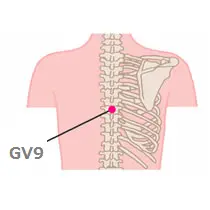
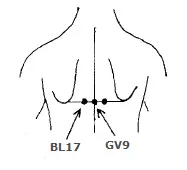
WHO : In the upper back region, in the depression inferior to the spinous process of the seventh thoracic vertebra (T7), on the posterior median line.
Note: The depression inferior to the spinous process of the seventh thoracic vertebra (T7) which is at the intersection of two imaginary lines: the posterior midline and the horizontal line of the inferior border of the inferior angle of the scapula.
GV-10 霊台
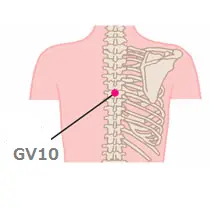
WHO : In the upper back region, in the depression inferior to the spinous process of the sixth thoracic vertebra (T6), on the posterior median line.
GV-11 神道
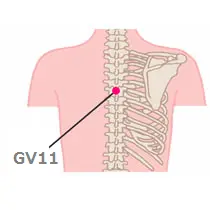
WHO : In the upper back region, in the depression inferior to the spinous process of the fifth thoracic vertebra (T5), on the posterior median line.
GV-12 身柱
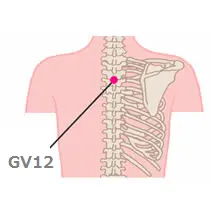
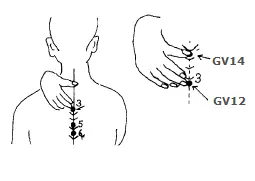
WHO : In the upper back region, in the depression inferior to the spinous process of the third thoracic vertebra (T3), on the posterior median line.
Note: The depression inferior to the spinous process of the third thoracic vertebra (T3) which is at the intersection of two imaginary lines: the posterior median line and the horizontal line of the medial end of the spine of the scapula.
*チリゲとも呼ばれる
GV-13 陶道
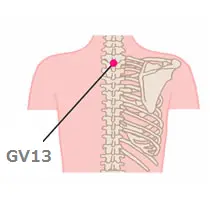
WHO : In the upper back region, in the depression inferior to the spinous process of the first thoracic vertebra (T1), on the posterior median line.
GV-14 大椎
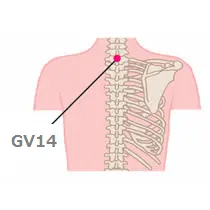
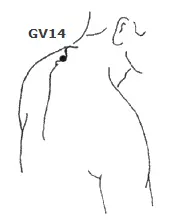
WHO : In the posterior region of the neck, in the depression inferior to the spinous process of the seventh cervical vertebra (C7), on the posterior median line.
Note 1: When the head is in a neutral position while the subject is seated, the most prominent site on the posterior aspect of the neck is the spinous process of the seventh cervical vertebra (C7). Forward flexion of the neck may facilitate palpation of the C7 spinous process. Note 2: Slight rotation of C7 can be palpated by rotating the head with the neck slightly flexed.
GGV-15 瘂門
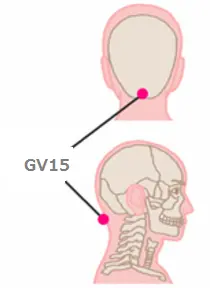
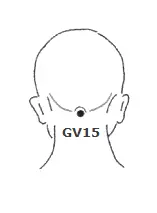
WHO : In the posterior region of the neck, in the depression superior to the spinous process of the second cervical vertebra (C2), on the posterior median line.
Note: After locating GV16, GV15 is located 0.5 B-cun inferior to GV16.
GV-16 風府
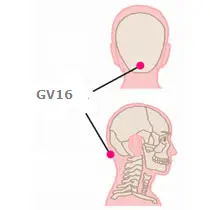
WHO : In the posterior region of the neck, directly inferior to the external occipital protuberance, in the depression between the trapezius muscles.
Note: With the head slightly extended in the seated position, loosen the trapezius muscle, then move superiorly from the midpoint of the posterior hairline to the occipital bone, GV16 will be found.
GV-17 脳戸
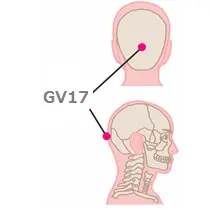
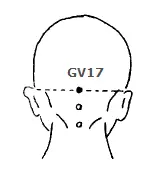
WHO : On the head, in the depression superior to the external occipital protuberance.
Note: GV17 is located in the depression at the intersection of two imaginary lines: the vertical line of the posterior median line and the horizontal line of the superior border of the external occipital protuberance, at the same level as BL9.
GV-18 強間
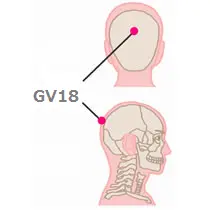
WHO : On the head, 4 B-cun superior to the posterior hairline, on the posterior median line.
Note: GV18 is located in the depression 1.5 B-cun superior to GV17.
GV-19 後頂
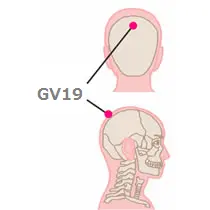
WHO : On the head, 5.5 B-cun superior to the posterior hairline, on the posterior median line.
Note: GV19 is located 1.5 B-cun posterior to GV20.
GV-20 百会
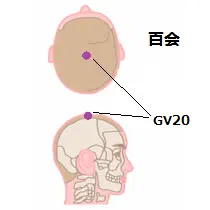
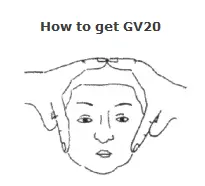
WHO : On the head, 5 B-cun superior to the anterior hairline, on the anterior median line.
Note 1: GV20 is located in the depression 1 B-cun anterior to the midpoint of the line from the anterior hairline to the posterior hairline.
Note 2: When the ears are folded, GV20 is located at the midpoint of the connecting line between the auricular apices.
GV-21 前頂
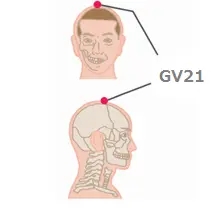
WHO : On the head, 3.5 B-cun superior to the anterior hairline, on the anterior median line.
Note: GV21 is located at the midpoint of the line connecting GV20 and GV22.
GV-22 顖会
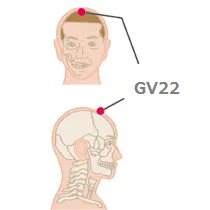
WHO : On the head, 2 B-cun superior to the anterior hairline, on the anterior median line.
GV-23 上星
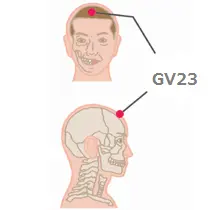
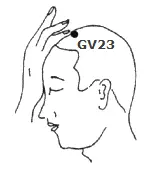
WHO : On the head, 1 B-cun superior to the anterior hairline, on the anterior median line.
GV-24 神庭
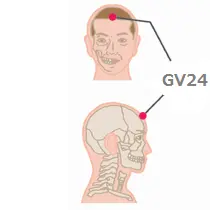
WHO : On the head, 0.5 B-cun superior to the anterior hairline, on the anterior median line.
Note: When the anterior hairline is unclear or changed, GV 24 is located 3.5 B-cun superior to the midpoint between the medial ends of the eyebrows.
GV-25 素髎
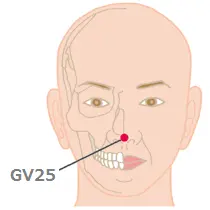
WHO : On the face, at the tip of the nose.
GV-26 水溝
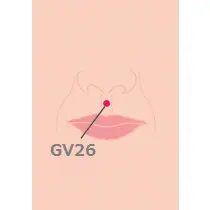
WHO : On the face, at the midpoint of the philtrum midline.
Remarks: Alternative location for GV26 – At the junction of the upper one third and lower two thirds of the philtrum midline.
GV-27 兌端

WHO : On the face, at the midpoint of the tubercle of the upper lip.
<
GV-28 齦交
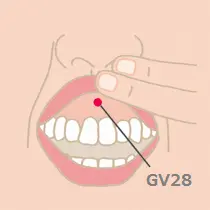
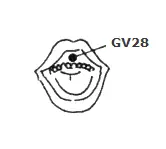
WHO : On the face, at the junction of the frenulum of the upper lip with the upper gum.
Note: With the head extended in the seated posture and the upper lip lifted, GV28 is located at the junction of the frenulum of the upper lip with the upper gum.
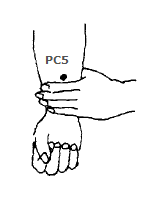
Pericardium Meridians (PC) and Acu points
Pericardium Meridian(PC) for Acupuncture and Moxabustion 手厥陰心包経
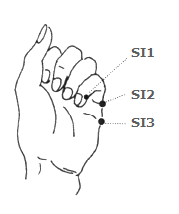
Small Intestine (SI) Meridian and Acu points
Small Intestine Meridian(SI) for Acupuncture and Moxabustion 手太陽小腸経

